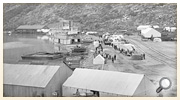
In July 1896 Dawson City didn’t yet exist; one year later it had a population of 5,000, the year after that, 30,000. Forty Mile, once the region’s principal community, was virtually abandoned. NWMP Inspector Charles Constantine, based at Forty Mile, had been the first — and, for several years, the only — person to administer mining regulations in the Yukon; the office was transferred to Dawson in 1897.
Money itself was rare. Gold dust — worth about 16 dollars an ounce — was the common currency. Many other things were rare as well. It was almost impossible to find a cabin to live in, even if someone was willing to pay the high rent. Building a cabin was also an expensive proposition; according to Thomas Fawcett, “Common lumber, which in Ontario would not cost more than $6 or $7 per 1,000 feet, is in demand at $140.”

Front Street, Dawson, in early 1898
Yukon Archives, Alaska Historical Library photograph collection, #4178
We were finally safely tied up and we stepped off the crude craft which had borne so many miles. We faced a crowd of people, containing as many classes as the world knows.
DIARY OF GRACE BARTSCH, MAY 24, 1900

Front Street, Dawson, in late 1898
Yukon Archives, Robert P. McLennan fonds, #6480
Some people took jobs in the town or at a mine. Claims were bought, sold and leased, either to make a profit or because the owner needed the money. A somewhat plaintive ad in the Klondike Nugget of July 27, 1898, reads: “Wanted to trade — Will trade a half-interest in a mining claim for a year’s provisions.”
By early 1897 the Tr’ondëk Hwëch’in had moved away from Tr’ochëk to a traditional camp downriver called Jëjik Ddhä̀ Dë̀nezhu Kek´it (Moosehide). Although the gold rush brought new economic opportunities for the territory’s First Nations people, it also created great social and cultural upheaval.
By late 1898, however, the rush was starting to subside. Even before the stampeders arrived in Dawson, almost all of the productive ground had already been staked. Thousands of hopefuls gave up their dream of wealth and left the territory. The discovery of gold in Nome, Alaska, in 1899 drew thousands more. The rush was over almost as quickly as it began, leaving in its aftermath a cosmopolitan community with electric lights, telephones, substantial buildings and four newspapers.
Women
Although author Jeremiah Lynch stated that “it took love and persuasion combined to induce women to come to the Far North,” women did travel to Dawson. Some accompanied their husbands; others came to work, some as clerks, cooks, domestic servants, teachers and nurses, some as dance-hall girls or prostitutes. Belinda Mulrooney became a hotel owner and successful entrepreneur. L.B. May, writing at Lindeman on March 31, 1897, noted: “there are several women in camp, among them our doctor.”

Waiting for mail, Dawson. The Klondike Nugget of July 16, 1898 reported that a man had stood in line at the post office “from one o’clock in the afternoon until five in the evening and the closing of the doors found him still number thirty five from that passageway.”
Yukon Archives, Robert P. McLennan fonds, #6487







